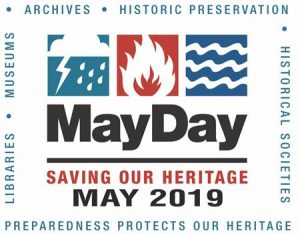 Happy May Day! Today is not just for dancing around the maypole and celebrating International Workers Day. May Day is also the traditional day to prepare for an emergency in your cultural institution. Are you ready?
Happy May Day! Today is not just for dancing around the maypole and celebrating International Workers Day. May Day is also the traditional day to prepare for an emergency in your cultural institution. Are you ready?
Today we invite you to do one thing to prepare for an emergency. If you don’t know where to start, we have some ideas for you below and in previous posts. Put 15 minutes on your calendar and pick one thing to do today.
Do One Thing
- Download the Heritage Preservation Emergency Response and Salvage Wheel iPhone app on your iPhone. It’s free!
- If you don’t have a smart phone, buy a copy of the Field Guide to Emergency Response (Supplements here) and the Salvage Wheel (English) (Salvage Wheel in Spanish). Both the book and wheel are on sale. $25 buys you both. These are excellent resources to help you get your disaster plan together and to respond to any emergency in your collections.
- Check your disaster kit. Do you need to restock or replace anything? Do you have a pair of warm socks in there? Do your emergency clothes still fit? [trust me…you want to know this ahead of time]
- Review your emergency phone tree. Are the correct people listed and the phone numbers still correct? If you don’t have a phone tree, make one today. List those critical people who need to be contacted first to get a recovery going. That might include the director, the communications director, the person who has the power to buy supplies on the spot, and a few people who can start the recovery process. It can be as simple as that. The Pocket Response Plan from the Council of State Archivists is a great customizable template and it fits in your pocket.
- Review your disaster plan. What’s missing or needs updating? Are there people listed that don’t work there anymore? Have the phone numbers changed? You don’t have to make all of those changes today, but make an appointment on your calendar to do it…then DO it!
- If you are not the one responsible for disaster planning or recovery in your institution, find out who is and ask for a copy of the disaster plan. And remember, if it is in electronic form, be sure to print out a copy and take it home. The internet doesn’t work when the power is out and cell phone towers are down.
- Find local and state disaster resources. The Alliance for Response is a coordinated effort to provide training and information at the state level. Current networks include North Carolina. The American Institute for Conservation has several emergency planning guides and templates.
- And don’t forget you need a plan at home, too. The Red Cross has some good information on how to put a disaster kit together for your home and family and templates in English and Spanish to help you create a family disaster plan.
It feels good to get that done, doesn’t it? Now, off to the maypole.

